Examining ICT Innovation for Sustainable Terminal Operations in Developing Countries: A Case Study of the Port of Radès in Tunisia
Abstract
:1. Introduction
2. Literature Review
2.1. ICT Solutions in Port Terminals
2.2. Performance Measures Used in the Maritime Sector
3. Materials and Methods
- A mapping and a comparison are performed between the port operation processes before and after the implementation of the TOS was conducted. The comparison was performed based on the following operations: pre-arrival and vessel planning, loading operations, unloading operations, yard operations, gate operations, and equipment handling and control. This mapping and comparison made it possible to identify the limitations and problems of the previous process, creating a need for the automation and implementation of an ICT solution.
- Analysis of the impacts of TOS implementation in the Port of Radès was performed through a statistical analysis. Unlike qualitative analysis, quantitative research methodologies the data to be interpreted and the findings to be presented straightforwardly and objectively. One of the common ways is to use surveys, which allow data to be gathered from individuals using a list of questions. For each question, a range of answers is provided. Thus, standardized and structured data can be obtained. This method is used at all levels, ranging from small-scale surveys such as might be used students or for small projects, to large-scale international surveys. The most important stage of the questionnaire is its design. Once the design of the questionnaire has been completed, the researcher will have determined the questions and answers, and it is not possible to go back in the process [33]. This analysis is based on a survey designed based on specific KPIs. The questions and answers were inspired by a survey performed by Navis (https://www.businesswire.com/news/home/20171024005433/en/Navis-N4-Customers-Report-Strong-Productivity-Improvements-and-Reduction-in-Operating-Costs, accessed on 28 May 2023), the company providing the TOS to STAM, and were related to the KPI categories defined by Elbert et al. [32], as shown in Figure 2.
3.1. Comparison of the Terminal Operations before and after TOS Implementation
3.1.1. Pre-Arrival and Vessel Planning
3.1.2. Unloading Operations
3.1.3. Loading Operations
3.1.4. Re-Stow Operations
3.1.5. Yard Operations
3.1.6. Gate Operations
3.1.7. Equipment Handling and Control
3.2. Survey Design and Sample Population
- Checklists contain a list of items, and the participant can check any of them that apply in the situation.
- Yes/No questions limit answers to these alternative responses.
- Multiple-choice questions contain different possible answers, and the participant is asked to select the most applicable ones.
- Percentage-rating scales require the participant to choose a percentage of improvement of several aspects using the following ranges: Up to 10%, 10–24%, 25–49%, 50–74%, 75% and greater.
- Productivity: How much would you estimate the following aspects have improved since TOS? The response consists of choosing a percentage of improvement of the following aspects: gate productivity, yard productivity, vessel handling, productivity, safety, reporting quality;
- Cost: In what areas has TOS helped to lower operational costs? The answer includes the following options: yard planning, quay crane planning, yard operations, gate operations, monitoring and reporting;
- Efficiency: Do you find that the delivery service time has been improved since TOS implementation?
- Reputation: Do you think that thanks to the TOS, the reputation of the Port of Radès (damages, accidents, safety, etc.) has been improved?
- Reliability: Do you find that the reliability in terms of punctuality (the capability to adhere to the planned schedule) has been enhanced since TOS implementation?
- Infrastructure: Do you find that the installed infrastructure (new port and terminal layout and facilities) has had a positive impact on work performance?
- Collaboration: Do you think that collaboration between port stakeholders has been improved since implementing the TOS?
- Customer Satisfaction: Has the service quality progressively improved since the implementation of the TOS?
4. Results
4.1. Statistical Analysis of the Survey
- Impact of the TOS on gate productivity: Figure 9a shows that the three stakeholders were almost in agreement on an improvement between 10% and 24%. This improvement remained limited because the enhancement of yard productivity leads to an increase in the number of gate flows, which requires new solutions such as the establishment of new gates in order to enhance both gate fluidity and yard operations. These results are in agreement with the of the Navis survey (https://www.businesswire.com/news/home/20171024005433/en/Navis-N4-Customers-Report-Strong-Productivity-Improvements-and-Reduction-in-Operating-Costs, accessed on 28 May 2023).
- Impact of the TOS on yard productivity: Figure 9b shows that 40% of maritime agents and port authorities evaluated yard productivity to be limited to between 25% and 49%, but 60% of the stevedoring company participants estimated the yard productivity to be between 50% and 74%. This implies that there was an improvement in the storage operations, and there is a relationship between the respondents, despite the slight gaps between the STAM respondents and the rest of the stakeholders. This is a result of the mitigation of the amount of manual work and the benefits brought by automation, which provides real-time visibility, accurate work performance, time gains, better work coordination between operations departments, and freedom from errors.
- Impact of the TOS on safety: Figure 9c shows that the results obtained from the three stakeholder groups were in agreement. Most of their answers lay in the interval from 50% to 74%. This can be explained by the contribution of the TOS to making vessel visits safer, improving the visibility of hazardous goods flowing through the port, and organizing the movement of engines inside the port with the new terminal layout.
- Impact of the TOS on reporting quality: Most of the respondents regarded the reporting quality to have been improved by the TOS, as shown in Figure 9d. This can be explained by the reporting functionality of the TOS, which helps by allowing real-time operational analysis when making strategic decisions on the basis of instant insights. However, based on the historical data provided via an in-house system, delays could affect decision making, especially when conclusions must be drawn immediately.
- Impact of the TOS on vessel handling productivity: Figure 9e shows that the OMMP respondents found that vessel handling was improved using the TOS by 25% to 49%, while 40% of the stevedoring company participants estimated that the improvement was between 50% and 74%. Nevertheless, 80% of the maritime responses varied between 25% and 75%.
4.2. Main Contributions
5. Discussion
- Automation and Robotics: Automated stacking cranes improve container handling efficiency by autonomously moving containers from storage yards to trucks or vessels. In addition, automated guided vehicles (AGVs) transport containers within the port, optimizing logistics and reducing the amount of manual labor required [36].
- The adoption of Machine Learning (ML) algorithms will enhance automation and robotics in ports. Advanced AGVs with autonomous decision-making capabilities, swarm robotics, and cooperative operation are expected to become more prevalent. However, high investment costs, challenges related to integration with existing infrastructure, and concerns regarding job displacement are some of the bottlenecks hindering the widespread implementation of automation and robotics in ports.
- Internet of Things (IoT) and Sensor Networks [37] is used in TOS and other platforms through the integration of sensors into containers in order to provide real-time data on location, temperature, humidity, and other relevant parameters. These devices and sensors monitor the movement and location of assets within the port, improving visibility and reducing the risk of loss or theft. Thus, the integration of IoT with blockchain technology enhances supply chain transparency, security, and traceability. As a future trend, edge computing and 5G networks will enable faster and more reliable data processing and communication within port ecosystems. However, challenges related to data security, the interoperability of diverse IoT devices, and the scalability of IoT deployments present significant bottlenecks. Additionally, the large volume of data generated by IoT devices requires effective data management and analytics solutions.
- Big Data Analytics is widely used in the context of predictive maintenance, predictive analytics, recommendations, and risk management. Future trends related to this area include the use of Artificial Intelligence (AI) and Machine Learning (ML), as they can play a significant role in enhancing the capabilities of big data analytics. Predictive models will become more accurate and adaptable, allowing for proactive decision making and the optimization of port operations [38]. Nevertheless, there are some potential bottlenecks, such as data quality and accessibility, privacy concerns, and the need for skilled data analysts. Additionally, the integration of data from various sources and systems can be complex.
- Green Technologies [39] have recently found use in the incorporation of shore power, whereby vessels are able to connect to the electrical grid while docked, thereby reducing emissions and noise pollution. In addition, alternative fuels can be used through the adoption of liquefied natural gas (LNG), hydrogen, or battery-powered vehicles and machinery in order to reduce carbon emissions. Renewable energy can also be incorporated through the implementation of solar panels, wind turbines, and energy storage systems in order to power port infrastructure. The increased use of renewable energy sources and the exploration of innovative solutions like green hydrogen production will be significant trends. However, the high upfront costs of implementing green technologies, the limited availability of and infrastructure for alternative fuels [40], and regulatory challenges regarding standards and incentives for green initiatives could hinder their widespread adoption [41].
6. Conclusions
Author Contributions
Funding
Institutional Review Board Statement
Informed Consent Statement
Data Availability Statement
Conflicts of Interest
Appendix A. Survey on the Impact of the TOS on Performance in the Port of Radès
- What are the main challenges in the Port of Radès? (You can choose more than one answer)
- -
- Optimize operations to improve productivity
- -
- Reduce cost of operations
- -
- Improve yard operations
- -
- Efficiently handle more TEU
- -
- Improve vessel planning and coordination
- -
- Improve truck turnaround time
- -
- Other
- What do you see as the most important benefits of the implementation of the TOS in the Port of Radès? (You can choose more than one answer)
- -
- Improve consistency of operations
- -
- Improve equipment utilization
- -
- Improve yard planning
- -
- Helps the team to work better
- -
- Improve the safety of operations
- -
- Optimize crane assignment
- -
- Efficient gate operation with faster truck turn times
- -
- Better visibility and reporting
- -
- Better monitoring tools to improve operations
- -
- More stable operations
- How much would you estimate the following aspects have improved since TOS?
- -
- Aspects: gate productivity, yard productivity, vessel load productivity, safety, reporting quality
- -
- Percentage choice: Up to 10%, 10–24%, 25–49%, 50–74%, 75% and greater.
- In what areas has TOS helped to lower operational costs?
- -
- Yard planning
- -
- Quay crane planning
- -
- Yard operations
- -
- Gate operations
- -
- Monitoring and Reporting
- -
- I don’t know
- 5.
- Has the cost in terms of fuel consumption, for instance, decreased since TOS implementation?
- 6.
- Do you find that the delivery service time has been improved since TOS implementation?
- 7.
- Do you think that thanks to the TOS the reputation of the Port of Radès (damages, accidents, safety, etc.) has been improved?
- 8.
- Do you find that the reliability in terms of punctuality (the capability to adhere to the planned schedule) has been enhanced since TOS implementation?
- 9.
- Does the TOS contribute to decreasing air pollution and improving the environment?
- 10.
- Do you think that collaboration between port stakeholders has been improved since implementing TOS?
- 11.
- Do you think that collaboration between different departments of STAM has been improved since implementing TOS?
- 12.
- Do you find that the installed infrastructure (port and terminal layout and facilities) has a positive impact on work performance?
- 13.
- Has the storage capacity been increased since installing 6 RTG and changing the terminal layout?
References
- Sirimanne, S.N.; Hoffman, J.; Juan, W.; Asariotis, R.; Assaf, M.; Ayala, G.; Benamara, H.; Chantrel, D.; Hoffmann, J.; Premti, A. Review of Maritime Transport 2019; United Nations Conference on Trade and Development: Geneva, Switzerland, 2019. [Google Scholar]
- Wang, Q.; Huo, B.; Zhao, X. What makes logistics integration more effective? Governance from contractual and relational perspectives. J. Bus. Logist. 2020, 41, 259–281. [Google Scholar] [CrossRef]
- Gleghorn, G.D.; Harper, A. Logistics and Supply Chain Management and the Impact of Information Systems and Information Technology. In Technology, Innovation, and Enterprise Transformation; IGI Global: Hershey, PA, USA, 2015; pp. 295–301. [Google Scholar]
- Castillo-Manzano, J.I.; Castro-Nuno, M.; Laxe, F.G.; López-Valpuesta, L.; Arévalo-Quijada, M.T. Low-cost port competitiveness index: Implementation in the Spanish port system. Mar. Policy 2009, 33, 591–598. [Google Scholar] [CrossRef]
- Baştuğ, S.; Haralambides, H.; Esmer, S.; Eminoğlu, E. Port competitiveness: Do container terminal operators and liner shipping companies see eye to eye? Mar. Policy 2022, 135, 104866. [Google Scholar] [CrossRef]
- Fan, G.; Xie, X.; Chen, J.; Wan, Z.; Yu, M.; Shi, J. Has China’s Free Trade Zone policy expedited port production and development? Mar. Policy 2022, 137, 104951. [Google Scholar] [CrossRef]
- Kuznetsov, A.; Dinwoodie, J.; Gibbs, D.; Sansom, M.; Knowles, H. Towards a sustainability management system for smaller ports. Mar. Policy 2015, 54, 59–68. [Google Scholar] [CrossRef]
- Yadav, G.; Kumar, A.; Luthra, S.; Garza-Reyes, J.A.; Kumar, V.; Batista, L. A framework to achieve sustainability in manufacturing organisations of developing economies using industry 4.0 technologies’ enablers. Comput. Ind. 2020, 122, 103280. [Google Scholar] [CrossRef]
- Matta, S.; Appleton, S.; Bleaney, M. The impact of the Arab Spring on the Tunisian economy. World Bank Econ. Rev. 2019, 33, 231–258. [Google Scholar] [CrossRef]
- World Bank. The Container Port Performance Index 2021: A Comparable Assessment of Container Port Performance; World Bank: Washington, DC, USA, 2022. [Google Scholar]
- Balfaqih, M.; Alharbi, S.A. Associated Information and Communication Technologies Challenges of Smart City Development. Sustainability 2022, 14, 16240. [Google Scholar] [CrossRef]
- Sanders, N.R.; Boone, T.; Ganeshan, R.; Wood, J.D. Sustainable supply chains in the age of AI and digitization: Research challenges and opportunities. J. Bus. Logist. 2019, 40, 229–240. [Google Scholar] [CrossRef]
- Zhang, X.; Xu, R.; Lu, K.; Hao, Z.; Chen, Z.; Cai, M. Resource-Based Port Material Yard Detection with SPPA-Net. Sustainability 2022, 14, 16413. [Google Scholar] [CrossRef]
- Taghipour, A.; Ramezani, M.; Khazaei, M.; Roohparvar, V.; Hassannayebi, E. Smart Transportation Behavior through the COVID-19 Pandemic: A Ride-Hailing System in Iran. Sustainability 2023, 15, 4178. [Google Scholar] [CrossRef]
- Cepolina, S.; Ghiara, H. New trends in port strategies. Emerging role for ICT infrastructures. Res. Transp. Bus. Manag. 2013, 8, 195–205. [Google Scholar] [CrossRef]
- Tliche, Y.; Taghipour, A.; Mahfod-Leroux, J.; Vosooghidizaji, M. Collaborative Bullwhip Effect-Oriented Bi-Objective Optimization for Inference-Based Weighted Moving Average Forecasting in Decentralized Supply Chain. Int. J. Inf. Syst. Supply Chain. Manag. (IJISSCM) 2023, 16, 1–37. [Google Scholar] [CrossRef]
- Fedi, L.; Lavissiere, A.; Russell, D.; Swanson, D. The facilitating role of IT systems for legal compliance: The case of port community systems and container Verified Gross Mass (VGM). Supply Chain. Forum Int. J. 2019, 20, 29–42. [Google Scholar] [CrossRef]
- Caporuscio, A.; Ferretti, M.; Leone, D.; Schiavone, F. Exploring knowledge sharing in sea-land logistics networks: Lessons from the port of Genoa. J. Innov. Econ. Manag. 2020, 33, 31–52. [Google Scholar] [CrossRef]
- Pagano, P.; Antonelli, S.; Tardo, A. C-Ports: A proposal for a comprehensive standardization and implementation plan of digital services offered by the “Port of the Future”. Comput. Ind. 2022, 134, 103556. [Google Scholar] [CrossRef]
- Heilig, L.; Voß, S. Information systems in seaports: A categorization and overview. Inf. Technol. Manag. 2017, 18, 179–201. [Google Scholar] [CrossRef]
- Hervás-Peralta, M.; Poveda-Reyes, S.; Molero, G.D.; Santarremigia, F.E.; Pastor-Ferrando, J.P. Improving the performance of dry and maritime ports by increasing knowledge about the most relevant functionalities of the Terminal Operating System (TOS). Sustainability 2019, 11, 1648. [Google Scholar] [CrossRef] [Green Version]
- Min, H.; Lim, Y.K.; Park, J.W. An integrated terminal operating system for enhancing the port security. Int. J. Logist. Syst. Manag. 2017, 34, 193–210. [Google Scholar] [CrossRef]
- Hervás-Peralta, M.; Poveda-Reyes, S.; Santarremigia, F.E.; Molero, G.D. Designing the layout of terminals with dangerous goods for safer and more secure ports and hinterlands. Case Stud. Transp. Policy 2020, 8, 300–310. [Google Scholar] [CrossRef]
- Keceli, Y.; Choi, H.R.; Cha, Y.S.; Aydogdu, Y.V. A study on adoption of port community systems according to organization size. In Proceedings of the 2008 Third International Conference on Convergence and Hybrid Information Technology, Busan, Republic of Korea, 11–13 November 2008; Volume 1, pp. 493–501. [Google Scholar]
- Cullinane, K.; Song, D.W.; Ji, P.; Wang, T.F. An application of DEA windows analysis to container port production efficiency. Rev. Netw. Econ. 2004, 3, 184–206. [Google Scholar] [CrossRef] [Green Version]
- Ha, M.H.; Yang, Z.; Notteboom, T.; Ng, A.K.; Heo, M.W. Revisiting port performance measurement: A hybrid multi-stakeholder framework for the modelling of port performance indicators. Transp. Res. Part E Logist. Transp. Rev. 2017, 100, 1–16. [Google Scholar] [CrossRef]
- Ha, M.H.; Yang, Z.; Heo, M.W. A new hybrid decision making framework for prioritising port performance improvement strategies. Asian J. Shipp. Logist. 2017, 33, 105–116. [Google Scholar] [CrossRef]
- Hinkka, V.; Porkka, J.; Fatima, Z.; Hyvärinen, J.; Huovila, A.; Morales-Fusco, P.; Martin, E.; Soley, G. Terminal planning: The selection of relevant KPIs to evaluate operations. In Proceedings of the 7th Transport Research Arena, TRA 2018, Vienna, Austria, 16–19 April 2018. [Google Scholar]
- Konsta, K.; Plomaritou, E. Key performance indicators (KPIs) and shipping companies performance evaluation: The case of Greek tanker shipping companies. Int. J. Bus. Manag. 2012, 7, 142. [Google Scholar] [CrossRef] [Green Version]
- Seguí, X.; Puig, M.; Quintieri, E.; Wooldridge, C.; Darbra, R.M. New environmental performance baseline for inland ports: A benchmark for the European inland port sector. Environ. Sci. Policy 2016, 58, 29–40. [Google Scholar] [CrossRef] [Green Version]
- Teerawattana, R.; Yang, Y.C. Environmental performance indicators for green port policy evaluation: Case study of Laem Chabang port. Asian J. Shipp. Logist. 2019, 35, 63–69. [Google Scholar] [CrossRef]
- Elbert, R.; Scharf, K.; Müller, J.P. The influence of digitalisation on the port choice behaviour—An analysis of decision-makers in South-West Germany. In Proceedings of the 3rd Interdisciplinary Conference on Production, Logistics and Traffic (ICPLT), Darmstadt, Germany, 25–26 September 2017; pp. 1–4. [Google Scholar]
- Matthews, R.; Ross, E. Research Methods: A Practical Guide for the Social Sciences; Pearson Education Ltd.: London, UK, 2010. [Google Scholar]
- Parsons, V.L. Stratified sampling. In Wiley StatsRef: Statistics Reference Online; Wiley: Hoboken, NJ, USA, 2014; pp. 1–11. [Google Scholar]
- Kenyon, G.N.; Goldsmith, M.; Neureuther, B.D.; Zhou, D. Improving the return on investment in ports: Opportunities in data management. Marit. Econ. Logist. 2018, 20, 514–530. [Google Scholar] [CrossRef]
- Liu, L.; Qu, T.; Thürer, M.; Ma, L.; Zhang, Z.; Yuan, M. A new knowledge-guided multi-objective optimisation for the multi-AGV dispatching problem in dynamic production environments. Int. J. Prod. Res. 2022, 1–22. [Google Scholar] [CrossRef]
- Wang, Y.; Yang, Y.; Qin, Z.; Yang, Y.; Li, J. A Literature Review on the Application of Digital Technology in Achieving Green Supply Chain Management. Sustainability 2023, 15, 8564. [Google Scholar] [CrossRef]
- Dalaklis, D.; Nikitakos, N.; Papachristos, D.; Dalaklis, A. Opportunities and challenges in relation to big data analytics for the shipping and port industries. In Smart Ports and Robotic Systems: Navigating the Waves of Techno-Regulation and Governance; Palgrave MacMillan: London, UK, 2023; pp. 267–290. [Google Scholar]
- Chen, J.; Huang, T.; Xie, X.; Lee, P.T.W.; Hua, C. Constructing Governance Framework of a Green and Smart Port. J. Mar. Sci. Eng. 2019, 7, 83. [Google Scholar] [CrossRef] [Green Version]
- Deng, G.; Chen, J.; Liu, Q. Influence Mechanism and Evolutionary Game of Environmental Regulation on Green Port Construction. Sustainability 2022, 14, 2930. [Google Scholar] [CrossRef]
- Di Vaio, A.; Varriale, L. Management Innovation for Environmental Sustainability in Seaports: Managerial Accounting Instruments and Training for Competitive Green Ports beyond the Regulations. Sustainability 2018, 10, 783. [Google Scholar] [CrossRef] [Green Version]
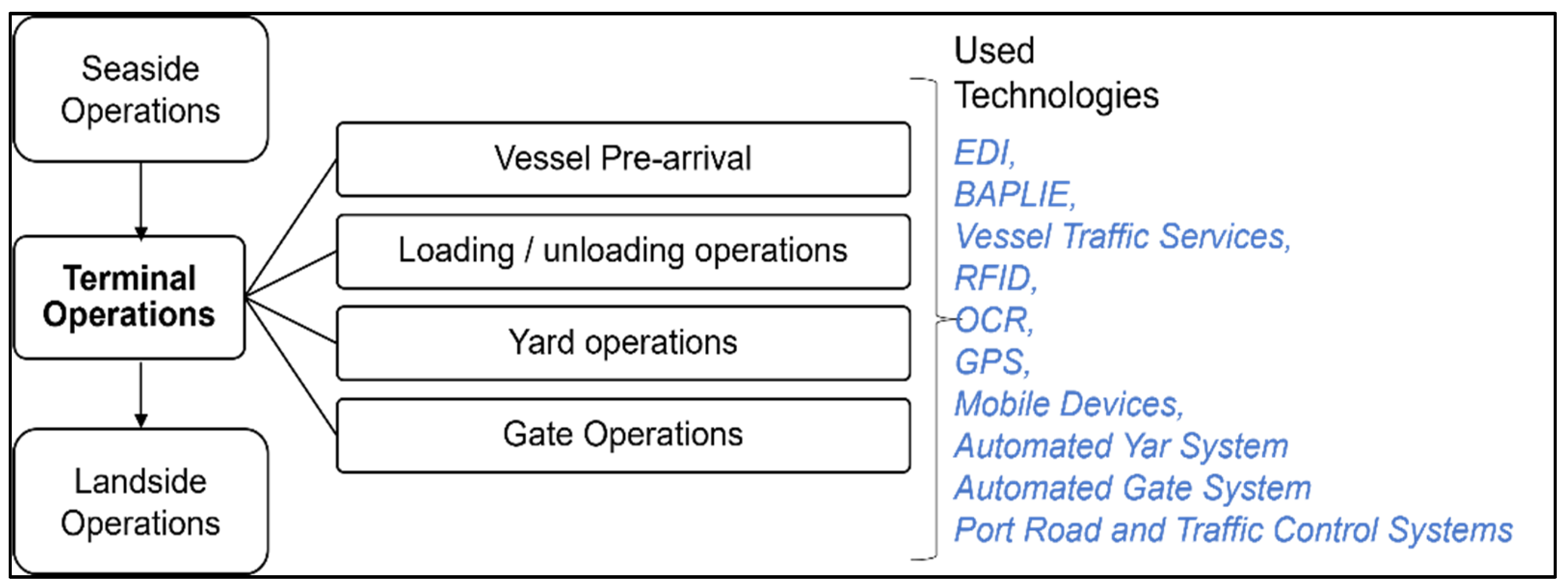


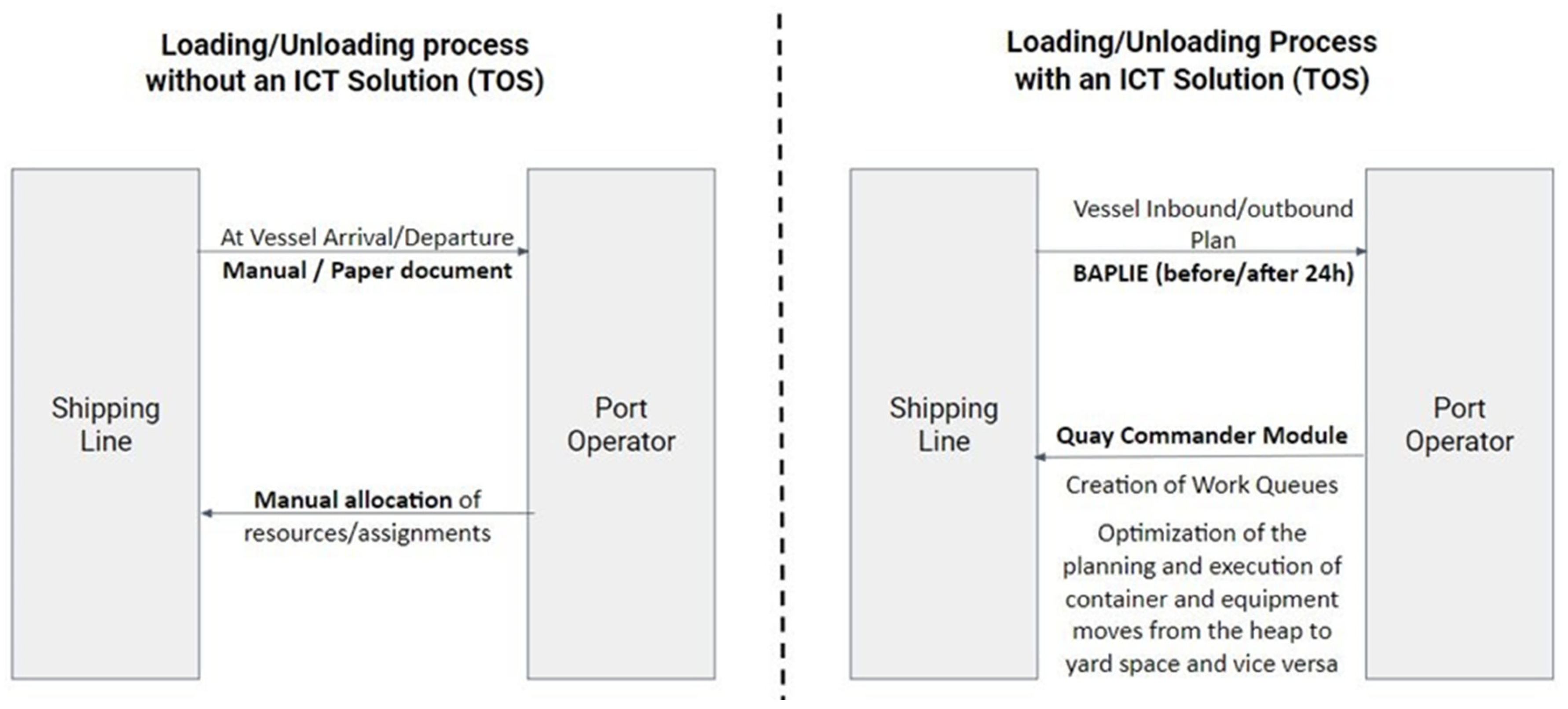

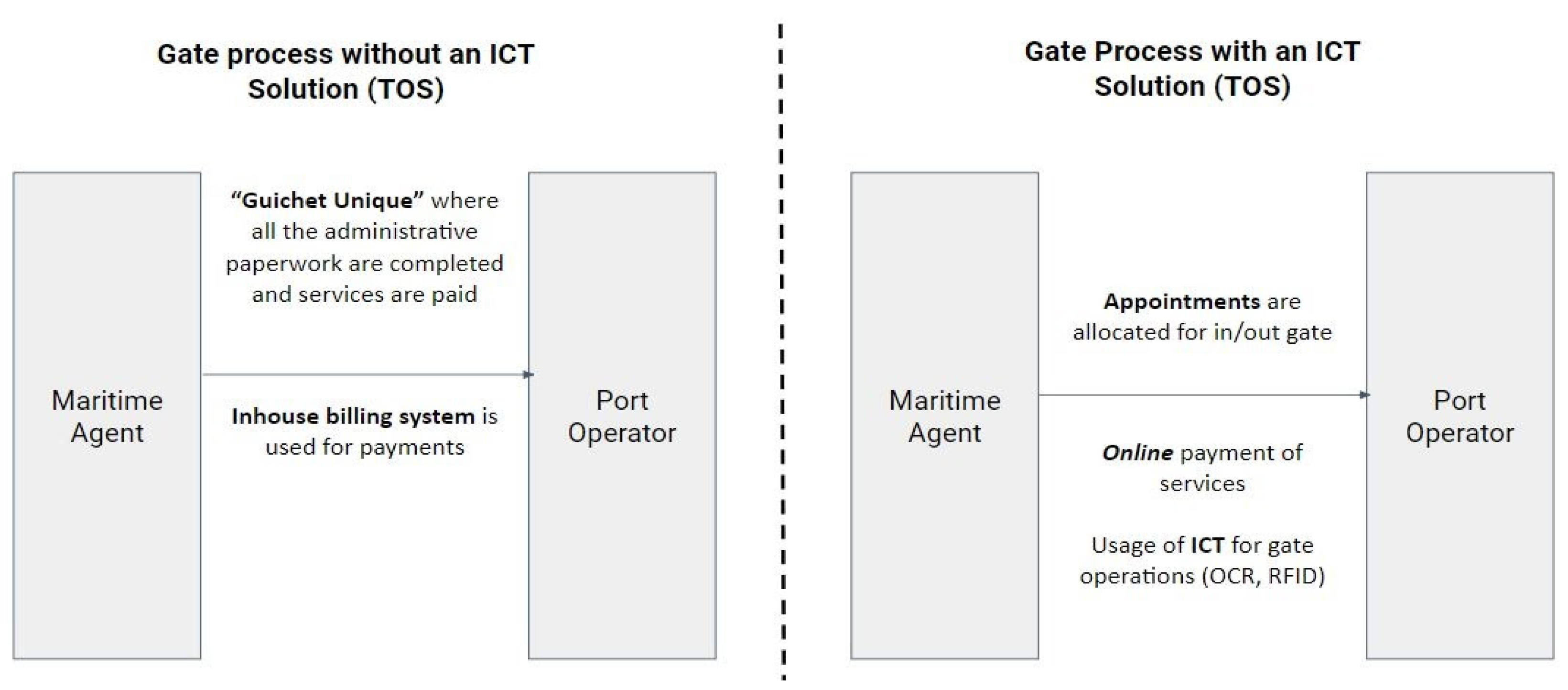
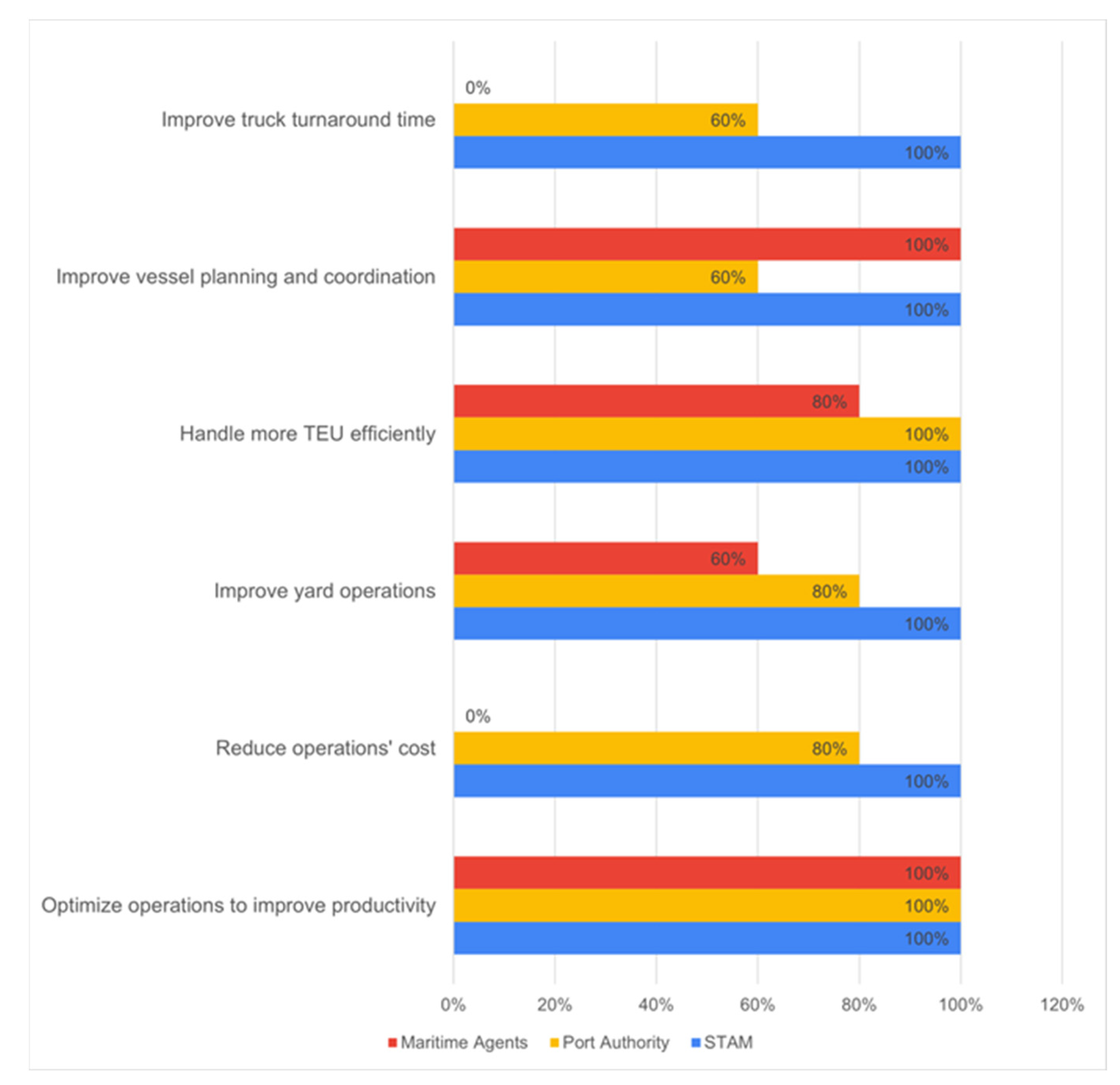
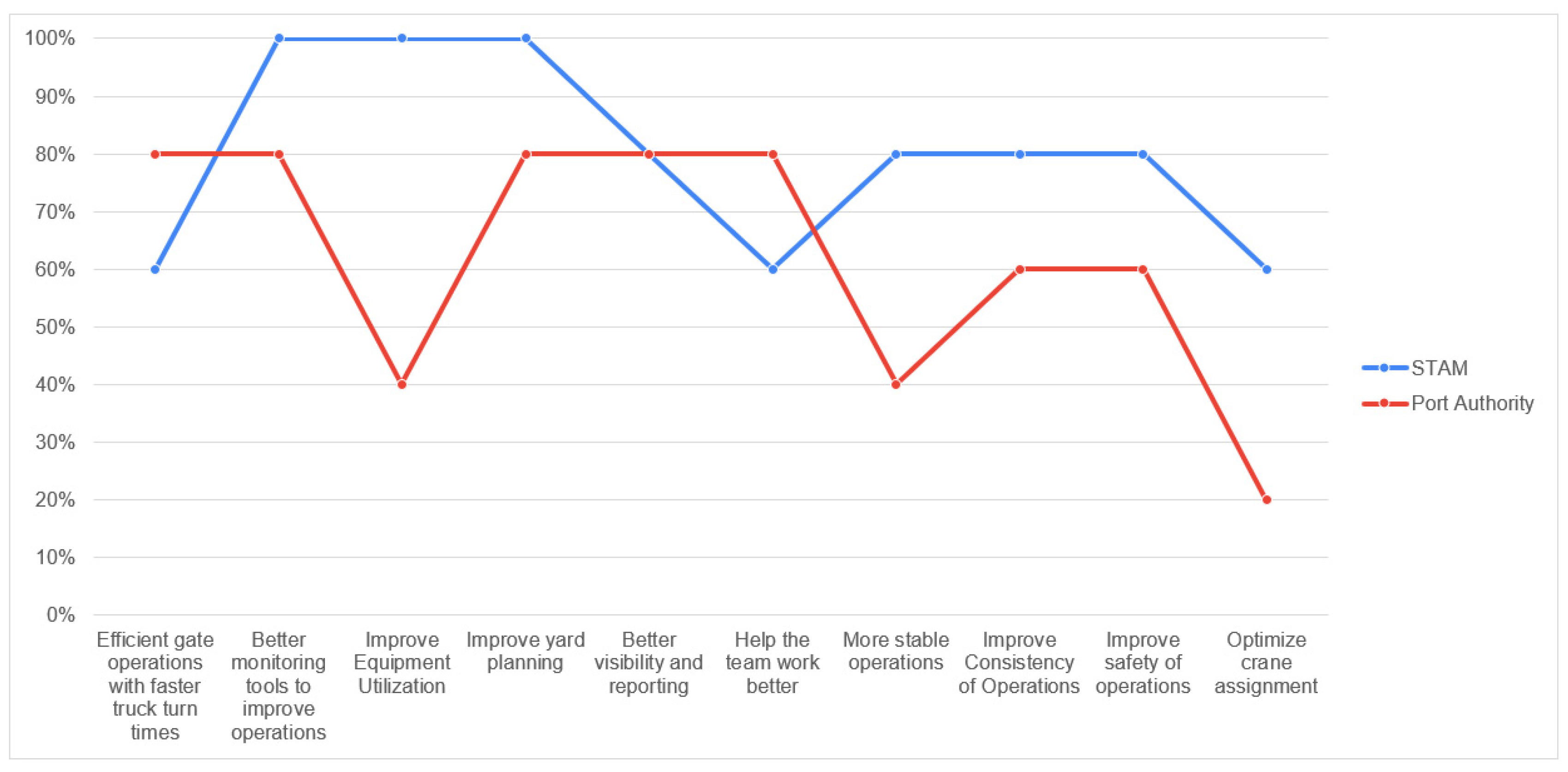
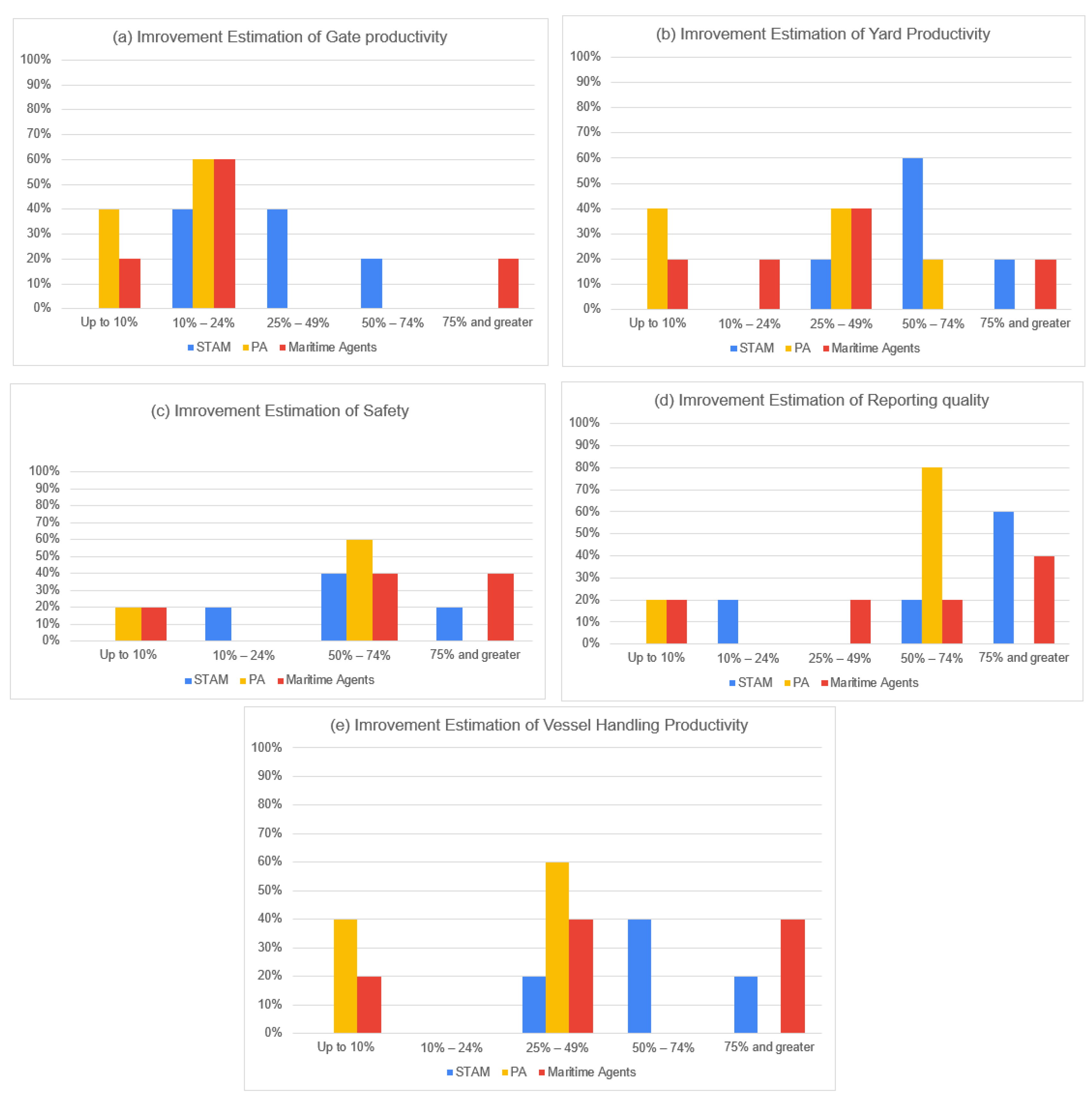
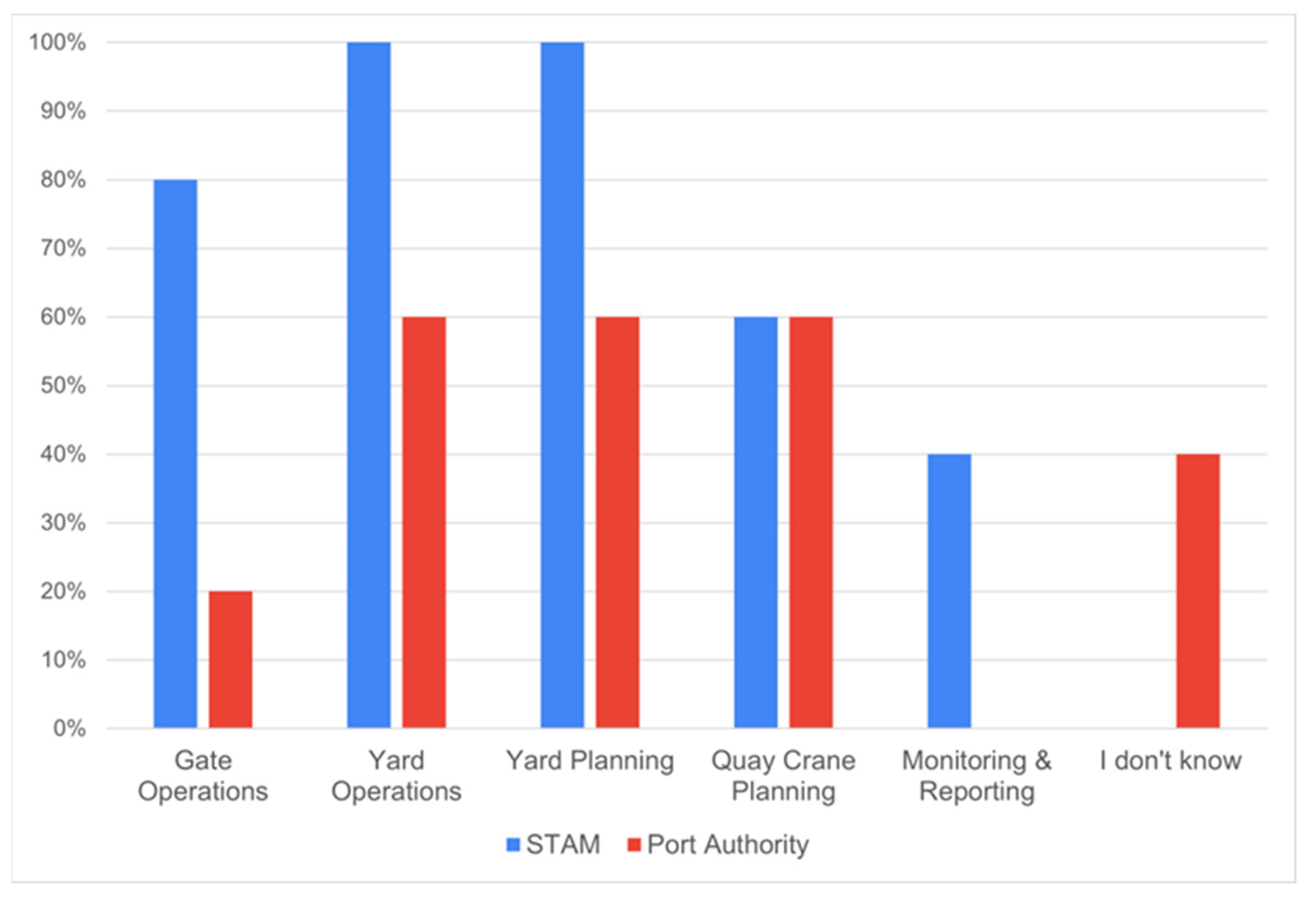
| Authors | Performance Framework | Performance Indicators | Approach |
|---|---|---|---|
| [1] | X | Different types of indicators | |
| [30] | X | Survey—Environmental performance indicators | |
| [27] | X | Analytic Hierarchy Process—Fuzzy technique for order preference | |
| [32] | X | Exploratory research study with 8 KPIs | |
| [22] | X | X | Exploratory analysis—Analytic Hierarchy Process |
| [28] | X | KPIs from different stakeholder groups’ perspectives | |
| [21] | X | Analytic Hierarchy Process | |
| [31] | X | Entropy approach—Environmental performance indicators |
| Actors | Process before TOS | Process after TOS | Used Technology |
|---|---|---|---|
| Pre-Arrival & Berth Planning | |||
| Maritime Agent, STAM, Port Authority | Pre-arrival information shared through TTN (Tunis Trade Net). Documents (such as Cargo Manifest) are provided to the port authority and the stevedoring company during the daily morning meeting. Planning of operations done the day of the arrival. | Pre-arrival information shared the same way through TTN (Tunis Trade Net). Documents (such as Cargo Manifest) are shared using Electronic Data Interchange (EDI). Vessel discharge planning done at least 24 h before the vessel arrival. Quay Commander affords real-time monitoring of crane schedules, vessel container moves, vessel activities, and vessel labor assignments. | Electronic Data Interchange (EDI) expedites order processing, facilitates prompt customer responses, and effectively organizes and secures data. It replaces traditional methods such as fax, phone, and email, thereby streamlining and enhancing the overall efficiency of the process. |
| Loading/Unloading Operations | |||
| STAM, Maritime agent, Drivers of equipment | Paper-based operations at the arrival of the vessel; manual allocation of resources/assignments. | TOS-based operations prior to vessel arrival; optimal resource planning, job scheduling, etc. | BAPLIE message helps to guide engine drivers to handle planned containers in terms of accuracy without making mistakes or losing time and provides real-time visibility. Defined as a message to transmit information about equipment and goods on a means of transport and location. |
| Yard operations | |||
| STAM | The planner of the yard operations used to carry out physical checks for empty blocks and coordinate with SC operators by radio. | AutoStow combines stowage factors (such as container length and weight) with yard constraints and operating parameters. Expert Decking allows utilization increase in yard space in order to handle growth especially with the new terminal layout and equipment | Expert Decking ensures that every container is allocated to its ideal location, resulting in significantly improved utilization of yard space. This innovative approach leads to a remarkable reduction of up to 90% in the need for re-handling containers. Moreover, it maximizes the efficiency of equipment usage, enabling businesses to accommodate growth without the necessity of acquiring additional land. |
| Gate operations | |||
| STAM, Maritime Agent, Customs | Operations managed manually. All administrative paperwork at the registration office “Guichet Unique”. An in-house billing system is used for invoices and collecting payments. | Appointment booking system. “Receive Export” gate operation where Container Number, Vessel Visit, Booking Number, Weight, Hazards, and Damages are specified. “Deliver Import” is where Container Number, Release Number, Bill of Lading, Line ID are indicated. | This module incorporates various technologies to enhance its functionality:
|
| Equipment Control | |||
| STAM | STAM uses straddle carriers, which are used as equipment that cover yard zones (similar to an RTG) rather than equipment that is linked to a crane. | Navis PrimeRoute joins carriers across a wide array of work assignments, breaking them up into distinct components, allowing for the efficient, real-time dispatching of the equipment to the work available. | The software application employs contemporary operational research optimization techniques to maximize the utilization of Container Handling Equipment. |
| Results after the Implementation of the TOS | Port Operator STAM | Port Authority OMMP | Maritime Agents | |
|---|---|---|---|---|
| Improvement in delivery service time | Yes | 100% | N/A | 80% |
| No | 0% | N/A | 20% | |
| Berthing time reduction | Yes | 80% | N/A | 80% |
| No | 20% | N/A | 20% | |
| Improvement in the reputation of the Port of Radès (damages, accidents, safety, etc.) | Yes | 100% | N/A | 80% |
| No | 0% | N/A | 20% | |
| Adaptation to the new system | Yes | 20% | 0% | N/A |
| No | 80% | 100% | N/A | |
| Improvement in gate fluidity | Yes | 60% | N/A | 20% |
| No | 40% | N/A | 80% | |
| Positive impact of the installed infrastructure (new port and terminal layout and facilities) | Yes | 100% | 100% | 100% |
| No | 0% | 0% | 0% | |
| Storage capacity increase after installing 6 RTG and changing the terminal layout | Yes | 100% | 100% | 100% |
| No | 0% | 0% | 0% | |
| Contribution to decreasing air pollution and improving the environment | Yes | 80% | 100% | 80% |
| No | 20% | 0% | 20% | |
| Problems Occurring before TOS | TOS Benefits |
|---|---|
|
|
Disclaimer/Publisher’s Note: The statements, opinions and data contained in all publications are solely those of the individual author(s) and contributor(s) and not of MDPI and/or the editor(s). MDPI and/or the editor(s) disclaim responsibility for any injury to people or property resulting from any ideas, methods, instructions or products referred to in the content. |
© 2023 by the authors. Licensee MDPI, Basel, Switzerland. This article is an open access article distributed under the terms and conditions of the Creative Commons Attribution (CC BY) license (https://creativecommons.org/licenses/by/4.0/).
Share and Cite
Sahraoui, A.; Tran, N.K.; Tliche, Y.; Kacem, A.; Taghipour, A. Examining ICT Innovation for Sustainable Terminal Operations in Developing Countries: A Case Study of the Port of Radès in Tunisia. Sustainability 2023, 15, 9123. https://doi.org/10.3390/su15119123
Sahraoui A, Tran NK, Tliche Y, Kacem A, Taghipour A. Examining ICT Innovation for Sustainable Terminal Operations in Developing Countries: A Case Study of the Port of Radès in Tunisia. Sustainability. 2023; 15(11):9123. https://doi.org/10.3390/su15119123
Chicago/Turabian StyleSahraoui, Ahmed, Nguyen Khoi Tran, Youssef Tliche, Ameni Kacem, and Atour Taghipour. 2023. "Examining ICT Innovation for Sustainable Terminal Operations in Developing Countries: A Case Study of the Port of Radès in Tunisia" Sustainability 15, no. 11: 9123. https://doi.org/10.3390/su15119123







